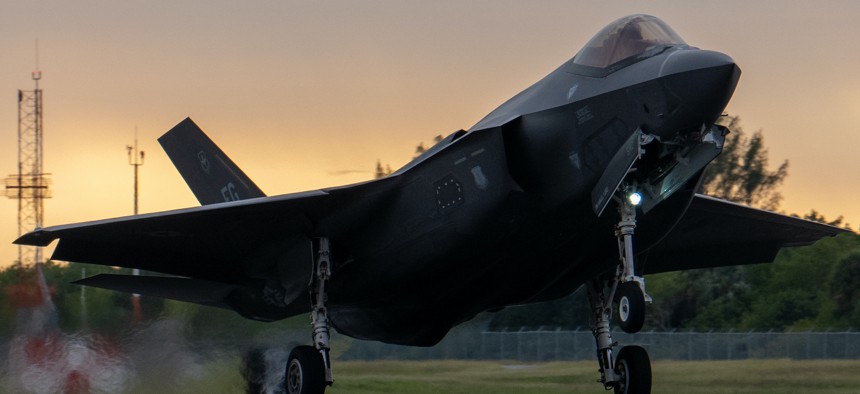
An F-35A Lightning II aircraft assigned to the 33rd Fighter Wing, Eglin Air Force Base, Florida, lands at MacDill Air Force Base, Florida, Dec. 16, 2022. U.S. Air Force / Airman 1st Class Zachary Foster
Defense Business Brief: Canada to buy F-35; Modified 747 to launch Navy satellites; FTC considers banning non-compete clauses; and more.
Canada will buy 88 F-35 stealth fighters to replace its F/A-18 fighters, it said today. The $19 billion deal—which Ottawa says is its largest Royal Canadian Air Force investment in three decades—comes after years of the country deliberating on whether to buy the Lockheed Martin-made jet.
“In today’s complex global environment, Canada requires a military that is flexible, agile and capable of responding to a variety of unforeseen situations,” Defense Minister Anita Anand said in a statement. “We are committed to ensuring that our current and future aviators have the most advanced equipment possible to do just that.”
Monday’s announcement is the culmination of more decades of back and forth over whether Canada would buy the stealth jet.
The backstory: Canada has been part of the then-named Joint Strike Fighter program since 1997, but has never purchased any jets, due to their high cost. There have also been questions about why Canada needs radar-evading jets when its fighters are used largely for homeland defense. In 2016, it delayed buying the F-35, opting instead to buy F/A-18 Super Hornets.
In the years since, the price of an F-35A—the standard version of the jet—has fallen considerably. In 2016, the planes cost about $102 million each. Today they cost about $78 million. The F-35’s mission potential has also increased beyond bombing enemy targets and shooting down aircraft, to include defending against missile attacks.
There are also a lot of F-35s out in the world now flying missions. Last week, the Pentagon announced a $30 billion order for nearly 400 jets. Some 894 F-35s are in service in the United States and allied militaries.
But that’s not to say there have not been problems. Currently F-35 deliveries are on hold following a crash at the F-35 factory in Texas last month. The planes will also need an estimated $15 billion in updates so they can use newer weapons.
Still, that has not deterred allies from buying the jet. Over the past year and a half, Switzerland, Finland, and Germany have all signed contracts to buy the F-35.
Also, congrats to Canada for its overtime gold medal victory in the 2023 World Junior Hockey Championship last week. Here’s a video of the game-winning goal.
Welcome
Happy New Year! You’ve reached the Defense Business Brief by Marcus Weisgerber. Send along your tips and feedback to mweisgerber@defenseone.com or @MarcusReports. Check out the Defense Business Brief archive here, and tell your friends to subscribe!
The Federal Trade Commission has proposed a rule that would ban employee non-compete clauses. The move would have broad-ranging implications across many sectors, including aerospace and defense. This means employees could jump between competitors that they previously would have been contractually prohibited from working for.
The Surface Navy Association’s National Symposium kicks off Tuesday in Arlington, Virginia. A sizable portion of Navy brass is scheduled to speak, including Secretary Carlos Del Toro and Adm. Mike Gilday, the chief of naval operations.
A modified Boeing 747 airliner will launch two Naval Research Lab satellites, along with other payloads, later Monday. It will be the first-ever commercial space launch in the United Kingdom, even though the rocket will deploy from the Virgin Orbit 747 at 35,000 feet. “Designated as Space Test Program (STP)-27VPD, the mission will launch the NRL’s Coordinated Ionospheric Reconstruction CubeSat Experiment (CIRCE) satellites,” the U.S. Space Force’s Space Systems Command said in an emailed statement. “Two 6U CubeSats will fly in tandem formation to measure the ionosphere and radiation environment from multiple vantage points.” The hourlong launch window opens at 2:46 p.m. Eastern time. You can watch the launch here.





